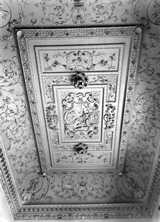 |
||||||||
| Ch‚telherault, Hamilton, South Lanarkshire | ||||||||
 © Country Life Picture Library |
Original plaster ceiling of west pavilion,
c.1919-20 The interior of what ranks as one of the largest and most elegant hunting lodges in Britain received a rich plasterwork finish, probably in the winter and spring of 1742-3, at the hands of the master stuccoist, Thomas Clayton, who in 1740 had already demonstrated his skill and artistry in the Hamilton apartments in Holyroodhouse, Edinburgh. The original work no longer survives, but was recorded by Country Life in 1919-20 when this photograph was taken. It shows the quality of rich decoration applied to the coved ceiling over the banqueting hall in the west pavilion, conceived and executed by Clayton in the style of Italian master stuccatori and of a quality which he went on to undertake in Hamilton Palace itself. |
|||||||
|
Clayton's technical ability to work in stucco as well as plaster was probably learnt from a foreigner, and an Italian connection is borne out by a few known facts of his family history. The eldest of Clayton's three sons, Thomas Varsallis Clayton, was born and registered at Hamilton in March 1743, when his father was working at 'The Wham'. His son's unusual middle name is clearly in honour of Francesco or John Vassalli, the distinguished stuccoists whose family hailed from the Lugano district of Italy and who worked on various houses in midland and northern England between 1724 and 1763. The baptismal entry for Thomas's third son, James, was also registered in Hamilton in April 1747, when Clayton senior was said to be 'working in stucko at the Palace'. |
||||||||
|
|
|
|
|
|
|
|
|
|
|
|
|
|
|
|
|
|
|
|
